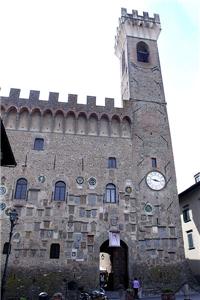
The small village of Scarperia was founded in 1306 and in fact got its name from the Castel S. Barnaba which was located at the foot or "scarpa" of the Appennine mountains and also marked the beginning of a steep and difficult slope or "ria".
Owing to its strategic position between the regions of Emilia and Northern Italy, within a short period of time, its commercial activity grew significantly, which brought with it a flourishing of guesthouses and inns, craftsmen's shops, amongst which the art of wrought iron gained particular prominence in the manufacture of agricultural tools and cutlery, in particular knives. Scarperia quickly became a wealthy centre of many different activities. In 1752, the new government of Lorena built the Futa carriageway, to improve the road network but which cut off Scarperia from the source of its livelihood.

The inns and taverns lost their trade and even the lives of the knife makers became difficult. In the first few decades of the 9th century, only 50 were left. At the start of the 20th century, the law which forbade the use of switchblades dealt another blow to this craft industry, which nevertheless managed somehow to survive despite these events and has even made a comeback in recent years.
Today, Scarperia is a beautiful little village with many of the qualities characteristic of Tuscany. Set in the midst of the lush green Mugello Valley, its surrounding countryside is full of olive trees, cypresses and fields of sunflowers and poppies.
Located in the middle of this area is the Palazzo dei Vicari, which was originally the residence of the Vicars, notable for its high crenellated tower designed by Arnolfo di Cambio and its decorated facade of around a hundred coat of arms of all the vicars who succeeded each other over the centuries, each one leaving the mark of his family's crest. Inside the Palazzo is the Museum of Sharp Instruments, which displays blades of all types and photographs that document the area's knife making industry. Located right next to the Museum is a knife making workshop where it is possible to discover the craft manufacture process of these utensils. Visitors will have the chance to experience its intricacy and can even have a go at trying out a hammer and anvil. Beautiful sculptures and paintings can be admired inside the Chiesa di SS. Jacopo e Filippo.